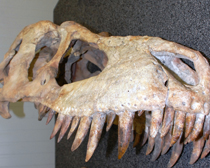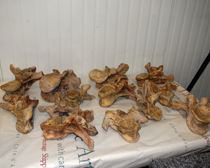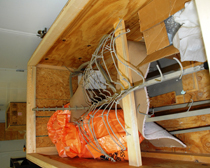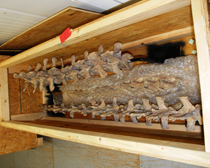Archived Content
In an effort to keep ICE.gov current, the archive contains content from a previous administration or is otherwise outdated. This information is archived and not reflective of current practice.
ICE takes custody of Tyrannosaurus dinosaur skeleton looted from Mongolia
NEW YORK — The nearly complete skeleton of a dinosaur was forfeited today to U.S. Immigration and Customs Enforcement's (ICE) Homeland Security Investigations (HSI) special agents. This action stems from an investigation by HSI and the U.S. Attorney's Office for the Southern District of New York.
The skeleton of a Tyrannosaurus Bataar dinosaur (the Tyrannosaurus Bataar Skeleton) was looted from the Gobi Desert in Mongolia. This forfeiture is the first step to the hopeful repatriation of the fossil to Mongolia.
"I thank and applaud the United States Attorney's Office in this action to recover the Tyrannosaurus Bataar, an important piece of the cultural heritage of the Mongolian people," said Tsakhiagiin Elbegdorj, president of Mongolia. "Cultural looting and profiteering cannot be tolerated anywhere and this cooperation between our governments is a large step forward to stopping it."
"As alleged, criminal smugglers misrepresented this fossil to customs officials when they illegally imported it into the United States," said ICE Director John Morton. "HSI works diligently to counteract loopholes smuggling organizations use to attempt to facilitate the entry of stolen and looted items into the United States illicitly."
"The skeletal remains of this dinosaur are of tremendous cultural and historic significance to the people of Mongolia, and provide a connection to the country's prehistoric past," said U.S. Attorney Preet Bharara, Southern District of New York. "When the skeleton was allegedly looted, a piece of the country's natural history was stolen with it, and we look forward to returning it to its rightful place."
According to court documents, the Tyrannosaurus Bataar, a native of what is now Mongolia, was a dinosaur from the late Cretaceous period, approximately 70 million years ago. It was first discovered in 1946 during a joint Soviet-Mongolian expedition to the Gobi Desert in the Mongolian Ömnögovi Province. Since 1924, Mongolia has enacted laws declaring dinosaur fossils to be the property of the Government of Mongolia and criminalizing their export from the country.
On March 27, 2010, the Tyrannosaurus Bataar skeleton was imported into the United States from Great Britain. The customs importation documents contained several misstatements. First, the country of origin of the Tyrannosaurus Bataar skeleton was erroneously listed as Great Britain. However, according to several paleontologists, Tyrannosaurus Bataars have only been recovered in Mongolia. In addition, the Tyrannosaurus Bataar skeleton was substantially undervalued on the importation documents. Customs importation forms listed its value as $15,000, in contrast to the $950,000 to $1.5 million price listed in a 2012 auction catalog. Finally, the Tyrannosaurus Bataar skeleton was incorrectly described on the customs importation documents as two, large, rough fossil reptile heads; six boxes of broken fossil bones; three rough fossil reptiles; one fossil lizard; three rough fossil reptiles and one fossil reptile skull.
Texas-based Heritage Auctions Inc., offered the Tyrannosaurus Bataar skeleton for sale at an auction conducted in New York. Prior to the sale, the Government of Mongolia sought — and was granted by a Texas Civil District Judge — a temporary restraining order prohibiting the auctioning, sale, release or transfer of the Tyrannosaurus Bataar skeleton. Notwithstanding the state court order, Heritage Auctions completed the auction and the Tyrannosaurus Bataar skeleton sold for $1.052 million. The sale, however, is contingent upon the outcome of any court proceedings instituted on behalf of the Mongolian Government.
On June 5, at the request of the President of Mongolia, several paleontologists specializing in Tyrannosaurus Bataars examined the Tyrannosaurus Bataar skeleton and concluded it is a Tyrannosaurus Bataar skeleton that was unearthed from the Western Gobi Desert in Mongolia between 1995 and 2005.
HSI plays a leading role in criminal investigations that involve the unauthorized importation and distribution of cultural property, as well as the illegal trafficking of artwork. The agency specializes in recovering works that have been reported lost or stolen. The HSI Office of International Affairs, through its 70 attaché offices in 47 countries, works closely with foreign governments to conduct joint investigations, when possible.
HSI specially trained investigators, assigned to both domestic and international offices, partner with governments, agencies and experts to protect cultural antiquities. They also train investigators from other nations and agencies on investigating crimes involving stolen property and art, and how to best enforce the law to recover these items when they emerge in the marketplace.
Since 2007, HSI has repatriated more than 2,500 items to more than 23 countries.
Learn more about HSI cultural property, art and antiquities investigations.
















